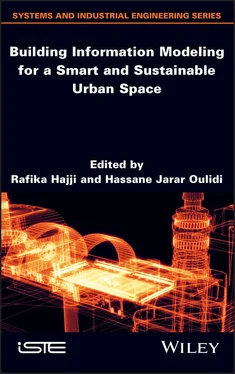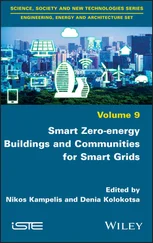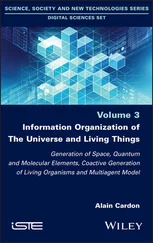Building Information Modeling for a Smart and Sustainable Urban Space
Здесь есть возможность читать онлайн «Building Information Modeling for a Smart and Sustainable Urban Space» — ознакомительный отрывок электронной книги совершенно бесплатно, а после прочтения отрывка купить полную версию. В некоторых случаях можно слушать аудио, скачать через торрент в формате fb2 и присутствует краткое содержание. Жанр: unrecognised, на английском языке. Описание произведения, (предисловие) а так же отзывы посетителей доступны на портале библиотеки ЛибКат.
- Название:Building Information Modeling for a Smart and Sustainable Urban Space
- Автор:
- Жанр:
- Год:неизвестен
- ISBN:нет данных
- Рейтинг книги:3 / 5. Голосов: 1
-
Избранное:Добавить в избранное
- Отзывы:
-
Ваша оценка:
- 60
- 1
- 2
- 3
- 4
- 5
Building Information Modeling for a Smart and Sustainable Urban Space: краткое содержание, описание и аннотация
Предлагаем к чтению аннотацию, описание, краткое содержание или предисловие (зависит от того, что написал сам автор книги «Building Information Modeling for a Smart and Sustainable Urban Space»). Если вы не нашли необходимую информацию о книге — напишите в комментариях, мы постараемся отыскать её.
Building Information Modeling for a Smart and Sustainable Urban Space — читать онлайн ознакомительный отрывок
Ниже представлен текст книги, разбитый по страницам. Система сохранения места последней прочитанной страницы, позволяет с удобством читать онлайн бесплатно книгу «Building Information Modeling for a Smart and Sustainable Urban Space», без необходимости каждый раз заново искать на чём Вы остановились. Поставьте закладку, и сможете в любой момент перейти на страницу, на которой закончили чтение.
Интервал:
Закладка:
General context
BIM and 3D GIS for a multi-scale modeling of urban space
Urban space is both rich and complex. Its modeling must support the management of this urban complexity through the development of geometrically and semantically rich 3D models. Whatever the use, the availability of a 3D urban model is commonly accepted as a crucial need that requires organizations producing reference data to direct their developments towards the acquisition of 3D geographic reference systems.
The theme “Building” represents a reference component for spatial data infrastructures that shares relationships with other urban objects like infrastructures, city facilities, cadastral parcels, etc. In the Infrastructure for Spatial Information in the European Community (INSPIRE) directive, the theme “Building” is part of the reference data that is required in the European Data Infrastructure. According to the INSPIRE directive, the definition of a building is very broad:
A building is an enclosed construction above and/or underground, used or intended for the shelter of humans, animals or things or for the production of economic goods. A building refers to any structure permanently constructed or erected on its site.
Within an urban diversity, the building is an object of reference that is at the center of several issues and is the subject of several studies. The building is, among other things, a space for living, working and human activities, which consumes resources and which defines and controls the dynamics of the urban space.
Faced with a wide range of applications and user needs that are both varied and evolving, the consistency of a general purpose 3D model is difficult to implement in terms of the types of objects to be represented as well as their geometric and semantic accuracy specifications, since the levels of detail and accuracy are strongly related to one’s interest in the 3D objects to be represented in a specific application.
The process of digitizing a building leads to a complete, geometrically reliable and precise 3D representation, semantically annotated in the form of a building information system, commonly called BIM (Building Information Modeling). Through a collaborative process, BIM refocuses practices around a highly detailed digital model containing qualitative and quantitative information on a building, and allowing all stakeholders (project owners, architects, engineers, operators, owners, etc.) to coordinate their contributions throughout the lifecycle of the project. This process allows us to optimize the methods of the construction, management and operation of buildings and to become more efficient in terms of cost and time required for the development of a project.
BIM has its origins in 1962, where the basic premises were first established by Douglas C. Engelbart, who in his article “ Augmenting Human Intellect ” described the way in which the architect can perceive the evolution of their project with adjustments to information flows through an object-oriented design. In 1975, Eastman established the link between the architectural design of a building and the field of computer science, and then developed and implemented a Building Description System (BDS) that establishes the basis of object modeling through a model that encapsulates different information and their management within the BDS (Eastman 1975), in which the “element” is the basic unit to which information is added.
Today, BIM is one of the major technological innovations in the field of construction, providing a 3D information base for studies and simulations on an urban scale, including environmental studies, energy, noise, property value simulations, etc. BIM allows the characterization of the geometry of buildings, spatial relationships, quantities as well as properties of construction elements, cost, materials, etc. Beyond its contribution to the economy of construction through cost and time optimization, BIM responds to sustainable development through a model that integrates information on the elements of the model for intelligent and sustainable construction. Upon delivery of the building, an “as-built” version of the BIM represents the actual state of the building, which helps facility managers to undertake maintenance and intelligent building management operations.
At an urban scale, GIS (Geographic Information System) is proving to be a powerful system for managing spatial phenomena. It must therefore be aligned with the increased need for rich and well-structured three-dimensional data that can offer advanced functionalities in a 3D space. The problem is not reduced to a simple extension of 2D GIS solutions by adding a third dimension, but requires consistent modeling, representation, storage and 3D spatial analysis for an optimal management of 3D data.
Through the capture, modeling, storage, manipulation, analysis, sharing and representation of geographically referenced data, 3D GIS describes information about the environment as it is captured at different times in a 3D environment. However, it provides access to data that is less detailed than data from BIM, but more up-to-date and covers a wide spatial extent (Worboys and Duckham 2004), therefore giving BIM and 3D GIS two different scales of modeling and analysis.
Trivially, the development of a 3D GIS is motivated by the increased demand for 3D information, and also by the technological revolution in 3D data acquisition, 3D reconstruction and modeling, new 3D visualization techniques such as virtual, augmented or mixed reality, and 3D spatial analysis. The challenge today is to choose the most appropriate technique for modeling a given spatial problem, from a range of 3D acquisition solutions, which is continuously developing and increasingly accessible to (initially) non-expert users. The difficulty lies rather in the implementation of solutions for processing, optimized storage and knowledge extraction from a 3D dataset. Moreover, the quality and integrity of the acquired data are two important parameters to be taken into consideration in the development of 3D models.
BIM-3D GIS integration: A new paradigm for a smart and sustainable urban space
The planning and management of the built environment requires at least two levels of analysis and planning, either at the city or neighborhood scale (GIS) or at the building scale (BIM). An integration of both BIM and 3D GIS models will be beneficial to adapt urban territories to the digital age. The current research trend is towards the integration of approaches from the geographic information domain (3D GIS) and the architectural and engineering domain (BIM). The challenge is to make a multi-scale modeling of urban space.
The result of this integration is GeoBIM, a hybrid process that combines information from the BIM micro-scale (building) and the GIS macro-scale (neighborhood, city, region, etc.). Thanks to its very detailed and precise information on the elements of a building, the BIM feeds the information represented by the GIS; the latter contains more general information and extends to a wider spatial context.
One example of the potential of 3D GIS is its ability to provide a platform for the simulation of urban issues related to the concept of a “Smart City”. If the major issue for politicians today is sustainable construction and the implementation of green strategies for new cities, the upgrading of existing buildings to meet the axes of sustainable development is not to be overlooked. 3D GIS plays a major role in this context. On the other hand, BIM provides very detailed and well-structured information about the building which allows its design, construction, management and operation to proceed in a sustainable and intelligent way.
Faced with a sustained urban dynamic and taking into account economic, social and environmental changes as well as the reforms undertaken, the territories of tomorrow are called upon to develop a capacity for resilience and sustainability capable of meeting the major challenges they face. Thus, the implementation of a new model of development and urban planning that responds to the many challenges of competitiveness, social cohesion, preservation of resources and sustainable development and innovation requires the development of concepts and new approaches to planning and a better integration of opportunities offered by new 3D technologies. The integration of 3D GIS and BIM allows the study of the dynamic relationship between physical and environmental conditions, urban geometry and the properties of each building. Such integration will help achieve smart, resilient and sustainable urban spaces (Niu et al . 2015). Having multi-scale urban models not only helps to meet the current requirements for urban space analysis and management, but also helps meet the future and prospective needs of tomorrow’s cities.
Читать дальшеИнтервал:
Закладка:
Похожие книги на «Building Information Modeling for a Smart and Sustainable Urban Space»
Представляем Вашему вниманию похожие книги на «Building Information Modeling for a Smart and Sustainable Urban Space» списком для выбора. Мы отобрали схожую по названию и смыслу литературу в надежде предоставить читателям больше вариантов отыскать новые, интересные, ещё непрочитанные произведения.
Обсуждение, отзывы о книге «Building Information Modeling for a Smart and Sustainable Urban Space» и просто собственные мнения читателей. Оставьте ваши комментарии, напишите, что Вы думаете о произведении, его смысле или главных героях. Укажите что конкретно понравилось, а что нет, и почему Вы так считаете.












